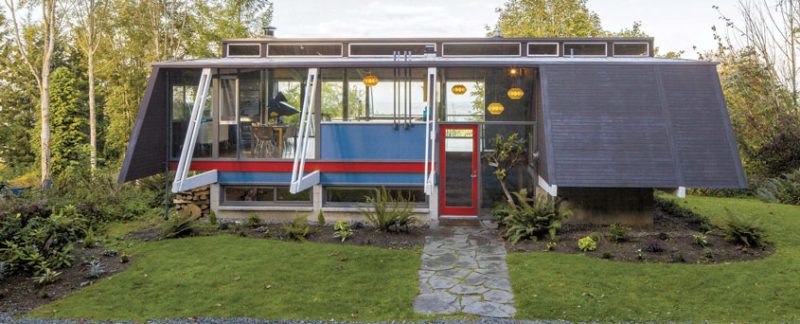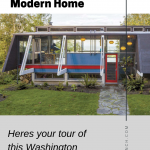Beginning in 1897, Wendell Lovett was one of seven architects who developed a 63-acre residential parcel in Bellevue, Wash.
“Hilltop is an area well known by MCM aficionados in our area,” says Kirsten Robertson, a realtor with 360° Modern in Seattle. “It is a unique community in that all of the 40 homes were constructed in a modern style and must stay that way—the Hilltop architecture committee ensures that. The lots are large, at over an acre each, and the homes range from 1,740 to well over 4,000 square feet.”
In 2012, Robertson had the listing for a distinctive Lovett home designed for Gervais and Connie Reed that had been feted in Domus, Arts & Architecture and several books when it was built in 1957. The hovering, split-level plan took advantage of views of the Cascades and Lake Sammamish by placing the public rooms on the upper level.
“The home was in original condition,” Robertson remarks. “Some upgrades had been made to the systems, namely converting from oil to gas heat, but not much more than that. The Reeds raised three kids there, and it was well loved but in very good condition for its age. There was a wall in the kitchen that still had the kids’ heights marked on it.”
The Buyers
Courtney and Patrick Stanton had already sold their 2004 Craftsman-style house and were looking for a smaller home on a larger lot closer to town. Coincidentally, both had grown up within a mile of Hilltop but were unaware of its existence.
“I saw the house online on a Sunday night and found the exterior really different,” remembers Patrick, a 44-year-old program manager for Nokia. “We looked at it on Monday and made an offer that night.” He liked the unique design and open floor plan, all of the windows and the fact that it was a house on a hill.

“I was in awe when we walked in. There’s a great openness to the house—even though we were going from a 5,000- to a 2,000-square-foot house—and it has a very homey feeling. When I came up the stairs and saw the spectacular view out the back, I was like, Done! You can write up the offer.”
Read More: Another Modern Marvel on Lake Sammamish
The couple liked most things about the house—the location, the lot, the two bedrooms, one bath and kitchen/dining/living room on the top level—but not the rabbit-warren lower level nor the original kitchen.
“It was very closed off,” Courtney says. “There was a tall bookcase by Wendell Lovett that blocked the view through the family room, and the side that adjoins the dining area had a standard refrigerator with hanging cabinets and just a low pass-through.”
“It was like a little cave in there,” chimes in Patrick. “We really liked the architectural style of the house, so when we decided to redo the kitchen, we wanted to maintain that; that’s why we brought Mike and Grace in.”
The Architects
Patrick had attended college with architects Mike Mariano and Grace Kim, now principals of Schemata Workshop in Seattle. They already knew Lovett’s work and this home, specifically.
“Lovett was one of the early modernists. This piece is considered to be an important project for him, done during an early phase of his career when he was heavily influenced by the Miesian idiom and the idea of using production components to create minimalist dwellings,” says Kim. “A good example [of that] would be the kitchen cabinets. They were not made of high-quality materials: The lumber was pretty low-grade plywood, and the cabinet faces were Masonite, while the drawer pulls were simple aluminum angles screwed to the faces.

“The kitchen was almost the first thing you saw as a visitor or resident returning home; it was a very forward-thinking move to liberate the kitchen and give it prominence,” she explains. “But despite Lovett’s good intentions, the kitchen is tiny and, with the bookcase and cabinets, it felt very hemmed in.

Courtney and Patrick wanted to feel more connected to family and guests when preparing meals, so we removed the upper cabinets separating the kitchen from the dining room, as well as the bookshelves that closed off the living room.” One of the first decisions Schemata made was to bring Kerf Design into the project. “Kerf has a certain aesthetic that doesn’t always lend itself to all projects or clients,” Kim says, “but it suits our sensibilities as a firm—Nathan’s work is very honest and clear—something we strive for in our work, also.”
The Cabinetmaker
Nathan Hartman runs a tight crew of five at Kerf Design, working with architects and homeowners to design and build furniture and custom cabinetry from plywood and laminate. The through-tenon joinery is visible, and instead of applied knobs or pulls, there are hand notches.

“I’d seen the listing when the Lovett house was on the market; I thought it was a cool house, so we were really excited when we got the call to work on it,” Hartman says. “It seemed like if Kerf had been in business when the house was built, there’s a pretty good chance we would have been the cabinetmakers for the project. The things the architect and the [original] owners were trying to accomplish were very similar to the style that we do.”
Both the Stantons and Schemata agreed. With a typical turnaround of about six weeks from final CAD drawings to finished cabinets, Kerf fit the bill for a quick project timeline.

“We work on the micro level—drawers over here, a door here, a pullout for a specific need you’ve identified. Sometimes the first design we show a homeowner is the way it goes, and sometimes it takes a few iterations,” Hartman comments. “We were worried that the homeowners were going to miss all of the upper cabinet storage,” says Kim.
“I first suggested some open shelves between the kitchen and dining room, but Courtney was smart: When they moved in, she didn’t put anything into any of the uppers to see if she’d need them. She confirmed that she wouldn’t.” To open the space up to the dining area, Schemata proposed losing the fridge and opting for Subzero drawer refrigerators; these would go into an island cabinet facing the living room, giving the homeowners that view they wanted.
Some details from the original kitchen were incorporated into the new design: the way the cabinet cases would attach to the posts with spacers, the slanted backs and the use of blue laminate. “Kerf seemed very European or Scandinavian, with the exposed edges and simplicity; we lived in Finland for two years, so we really liked that style,” says Courtney. And so Patrick and his dad razed the kitchen, beginning the 10- week process.
The Contractor
The kitchen remodel was both simple and detailed, requiring a project manager who sweats the small stuff. That would be Gary Timpe, co-owner of BrightWork Builders.
BrightWork—a name that refers to clear-finished wood that precludes using filler to hide any sloppy cuts—specializes in residential projects, with about half of their work in a contemporary style.
“I was immediately interested; it’s such a beautiful home and it matters to us what we’re building,” says Timpe, who oversaw and coordinated the subcontractors. Electrical, plumbing, gas lines, flooring, glass, countertop fabrication and even roofing were required, with most activity occurring during a three-week window.

In addition to the systems upgrades, a fixed window with a vent hole was replaced, a reeded-glass backsplash installed, terrazzo countertops cast and new appliances, fixtures and lighting installed. An exhaust fan over the gas cooktop necessitated piercing the membrane roof, and significant time was spent weighing options before selecting Expanko rubberized cork flooring for its visual simplicity and durability in a household with an 8-year-old and three large dogs.

An example of the project’s attention to detail is seen in the flooring install. Twenty-four-inch tiles were chosen because sheet goods would have had a seam at an unfortunate area. BrightWork demoed down to the floor joists, installed a subfloor, then the Expanko installer put in an additional, very smooth 3/8″ subfloor and floated out the seams so they had a perfectly flat surface. Today, the kitchen floor is slightly lower than the surrounding original floors, but that’s because the hardwood is due to be sanded and refinished shortly.
“It was mostly a logistical challenge—scheduling all of the subs and keeping things moving so we could return the kitchen to the homeowners as quickly as possible,” says Timpe. “It was well thought out from the beginning, and the cabinetmakers did an excellent job. There were none of those fire-drill moments where you scramble and freak out because something didn’t work.
Future plans include remodeling the upstairs bath, opening up the small rooms downstairs that were constructed in the ’70s and adding an outbuilding for an office/exercise room. Bringing in the pros was the right approach, the Stantons feel.
Not to mention, others love this Lovett renovation as well. “When an inspector came to look at the house when we were buying, he was like a kid in a candy store and offered to buy if we wanted to sell in five years,” Patrick recounts. “It’s such a simple design: There’s not anything complex about the structure, and the original owners did a good job keeping everything up.”
Inspired to renovate your MCM dream getaway? Check out this post on 10 Midcentury Hotspots in the country that may have you looking to make a move.
And of course, don’t forget to follow us on Instagram, Facebook and Pinterest for more Atomic Ranch articles and ideas!

















